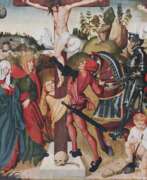Draftsmen 15th century


Albrecht Altdorfer, a notable German painter, engraver, and architect of the Renaissance era, was especially recognized for his contributions to landscape painting. Born around 1480, Altdorfer was a pivotal figure in the Danube School, distinguishing himself with his integration of natural landscapes into biblical and historical narratives.
His works are celebrated for their detailed and expressive landscapes, often serving as backdrops to religious and historical scenes. A hallmark of his style is the emotional intensity and vivid use of colors, which border on expressionistic in his religious scenes, particularly seen in works like the Sebastian Altar in St. Florian's Priory. Altdorfer's painting, "The Battle of Alexander at Issus," stands out for its epic portrayal of Alexander the Great's victory, showcasing Altdorfer's talent in blending historical narrative with dramatic landscape settings.
In addition to his artistic pursuits, Altdorfer was actively involved in the civic life of Regensburg, serving as its mayor in 1528. His legacy in the art world is profound, with his innovative approach to landscape painting influencing the course of European art.
For those interested in delving deeper into Albrecht Altdorfer's oeuvre or staying informed about related exhibitions and auction events, signing up for updates can provide valuable insights and opportunities.


Erhard Altdorfer, a German Early Renaissance printmaker, painter, and architect, is renowned for his contributions to the arts during the 16th century. Born around 1480, Altdorfer's career flourished in Schwerin, where he served as a court painter and architect for the Dukes of Mecklenburg from 1512 until his death in 1561. His journey into the arts likely began under the guidance of his older brother, Albrecht Altdorfer, a prominent figure in the same era.
Altdorfer's early work possibly included collaboration with his brother in Regensburg. By 1512, his talents led him to Schwerin, marking the start of a significant phase in his career. His oeuvre includes various forms, from engravings and woodcuts to paintings and architectural designs. Notable among his works are contributions to the Lübeck Bible, showcasing his skill in woodcut illustrations. Despite the limited number of signed works, his contributions to printmaking and painting hold a place in the history of German Renaissance art. His works, reflecting a blend of influences, including from Lucas Cranach the Elder and Jacopo de' Barbari, demonstrate a unique interpretation of the Renaissance style.
For collectors and experts in art and antiques, understanding Altdorfer's role within the context of the Early Renaissance and his contributions, especially in printmaking and painting, offers a nuanced appreciation of this period. His works, though not as prolifically signed as those of some contemporaries, remain significant for their historical and artistic value. To stay updated on new discoveries or auction events related to Erhard Altdorfer's works, consider signing up for updates to deepen your knowledge and collection of Renaissance art.


Amico Aspertini was an Italian Renaissance painter, draughtsman, and sculptor, considered one of the leading representatives of the Bolognese school of painting.
He was trained in the family workshop and was influenced by the artists of the Ferrara school, Ercole de'Roberti, Lorenzo Costa, and Francesco Francia. He worked as a painter and sculptor, and was also an excellent draughtsman, as evidenced by his many surviving drawings and sketches. Contemporaries marveled at his complex and impulsive character and noted that he worked with both hands simultaneously.
Aspertini painted splendid portraits as well as numerous frescoes and altarpiece paintings in chapels and churches in Italy. Many of his works are eccentric and eclectic, even whimsically fantastical, his complex style anticipating Mannerism.


Jörg Breu the Elder of Augsburg, was a painter of the German Danube school. He was the son of a weaver. He journeyed to Austria and created several multi-panel altarpieces there in 1500–02, such as the Melk Abbey altar (1502). He returned to Augsburg in 1502, where he became a master. He travelled to Italy twice, in ca. 1508 and in 1514/15.

















